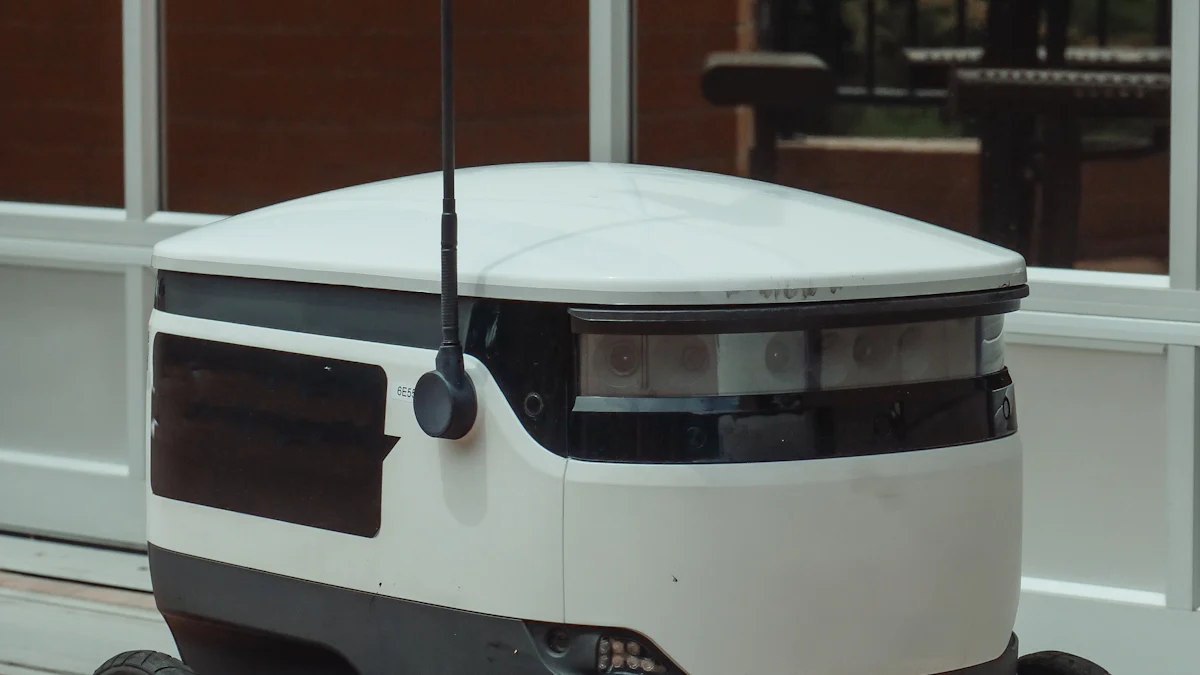How Microsoft is Preparing for the Rise of Autonomous Systems

Autonomous systems represent a transformative leap in technology, poised to redefine industries and daily life. Preparing for these advancements is crucial as the market size for autonomous and sensor technology is projected to reach US$6.80 billion by 2024. Microsoft Preparing for this shift underscores its pivotal role in technological innovation. The company invests heavily in research and development, ensuring it remains at the forefront of this evolution. By leveraging its expertise, Microsoft aims to seamlessly integrate autonomous systems into various sectors, enhancing efficiency and productivity.
Understanding Autonomous Systems
Definition and Characteristics
Autonomous systems represent a significant leap in technological innovation. These systems operate independently, making decisions without human intervention. They combine advanced technologies, such as artificial intelligence and sensor technology, to navigate and adapt to various environments. This capability allows them to perform complex tasks efficiently.
Key Features
Autonomous systems possess several defining features:
Self-governance: They function without direct human control.
Adaptability: They adjust to changing environments and conditions.
Decision-making: They analyze data to make informed choices.
Learning ability: They improve performance over time through experience.
These features enable autonomous systems to optimize operations and respond dynamically to their surroundings.
Types of Autonomous Systems
Autonomous systems encompass a wide range of applications. Some common types include:
Unmanned vehicles: Drones and self-driving cars fall into this category.
Robotic systems: These include industrial robots and service robots.
Smart devices: Home automation systems and personal assistants are examples.
Each type serves distinct purposes, yet they all share the core characteristics of autonomy and adaptability.
Current Trends
The rise of autonomous systems has sparked significant interest across various industries. Companies and organizations recognize the potential benefits of adopting these technologies.
Industry Adoption
Industries such as automotive, healthcare, and manufacturing have embraced autonomous systems. In the automotive sector, self-driving cars promise to revolutionize transportation. Healthcare providers use robotic systems for surgeries and patient care. Manufacturing facilities deploy autonomous robots to enhance production efficiency.
Technological Innovations
Technological advancements drive the evolution of autonomous systems. Innovations in AI and machine learning enable these systems to process vast amounts of data quickly. Sensor technology enhances their ability to perceive and interact with the environment. These innovations contribute to the growing capabilities and applications of autonomous systems.
"Autonomous systems can do a much better job of dealing with complexity and optimizing for all variables." - Select Autonomous Systems Use Case
As industries continue to adopt and innovate, autonomous systems will play an increasingly vital role in shaping the future of technology.
Microsoft's Vision for Autonomous Systems
Strategic Goals
Microsoft envisions a future where autonomous systems transform industries by integrating advanced technologies. The company focuses on empowering engineers to leverage AI for innovative solutions.
Long-term Objectives
Empowerment through AI: Microsoft aims to enhance traditional engineering with AI capabilities. This approach allows engineers to solve complex problems more efficiently.
Industry Transformation: By 2025, Microsoft plans to revolutionize sectors like manufacturing, energy, and robotics. The goal is to elevate automated capabilities, improving quality and consistency.
Global Collaboration: Microsoft seeks to partner with global leaders across various industries. These collaborations aim to drive innovation and expand the reach of autonomous systems.
Short-term Initiatives
Machine Teaching: Microsoft has pioneered machine teaching, enabling operators to instruct AI agents. This initiative accelerates the mastery of complex strategies by autonomous systems.
Sector-Specific Projects: The company actively engages in projects within smart buildings and consumer goods. These efforts focus on integrating intelligence into everyday operations.
Resource Allocation: Microsoft invests in resources to support rapid development and deployment of autonomous technologies. This includes funding research and enhancing infrastructure.
Leadership and Innovation
Microsoft's leadership in autonomous systems stems from its commitment to innovation and strategic partnerships.
Key Figures
Visionary Leaders: Key figures at Microsoft drive the vision for autonomous systems. Their expertise guides the development and implementation of cutting-edge technologies.
Expert Teams: Dedicated teams work on advancing AI and machine learning. These experts ensure that Microsoft's solutions remain at the forefront of technological innovation.
Innovation Labs
Research Facilities: Microsoft operates state-of-the-art labs focused on AI and robotics. These facilities foster creativity and experimentation, leading to groundbreaking advancements.
Collaborative Environments: Innovation labs encourage collaboration between engineers, researchers, and industry partners. This synergy results in robust solutions tailored to specific industry needs.
"Autonomous systems are transforming business by equipping manufacturers with intelligence for improving quality and consistency." - Microsoft
Microsoft's strategic goals and innovative leadership position the company as a pioneer in the rise of autonomous systems. Through continuous investment and collaboration, Microsoft aims to shape the future of technology.
Research and Development
Investment in R&D
Microsoft places a strong emphasis on research and development to drive the future of autonomous systems. The company allocates substantial resources to ensure continuous innovation and advancement.
Funding and Resources
Microsoft invests heavily in AI and cloud infrastructure. For instance, the company announced a US$2.9 billion investment in Japan to enhance its hyperscale cloud computing capabilities. This investment also includes expanding digital skilling programs, aiming to provide AI training to over 3 million people. Such financial commitments underscore Microsoft's dedication to leading technological progress.
Collaborative Projects
Collaboration plays a crucial role in Microsoft's R&D strategy. Through Project Bonsai, Microsoft partners with various industries, including manufacturing and robotics. This initiative empowers engineers to leverage AI for solving complex problems. By working closely with industry leaders, Microsoft accelerates the development of innovative solutions tailored to specific needs.
Key Technologies
Microsoft's focus on key technologies ensures that its autonomous systems remain cutting-edge and effective.
AI and Machine Learning
Artificial intelligence and machine learning form the backbone of Microsoft's autonomous systems. These technologies enable systems to process vast amounts of data and make informed decisions. Project Bonsai exemplifies how AI can transform traditional engineering, allowing for more efficient problem-solving across sectors like energy and smart buildings.
Cloud Computing
Cloud computing is another vital component of Microsoft's strategy. The company's investment in cloud infrastructure, particularly in regions like Japan, enhances its ability to support autonomous systems. This infrastructure provides the scalability and flexibility needed to handle complex computations and data storage, ensuring seamless integration and operation of autonomous technologies.
"Microsoft's commitment to AI and cloud infrastructure paves the way for groundbreaking advancements in autonomous systems." - Industry Expert
Through strategic investments and collaborations, Microsoft continues to lead in the research and development of autonomous systems, setting the stage for future innovations.
Case Studies and Examples

Successful Implementations
Automotive Industry
The automotive industry showcases significant advancements in autonomous systems. Companies like Microsoft have collaborated with leading car manufacturers to integrate AI-driven technologies. These partnerships aim to enhance vehicle safety and efficiency. Autonomous vehicles now navigate complex environments, reducing human error and improving traffic flow.
Key Achievements:
Enhanced navigation systems using AI.
Improved safety features through real-time data analysis.
Increased fuel efficiency by optimizing driving patterns.
"Autonomous systems in the automotive sector are transforming transportation by minimizing human intervention." - Industry Expert
Robotics and Automation
In robotics and automation, autonomous systems have revolutionized manufacturing processes. Microsoft’s innovations in AI and machine learning empower robots to perform intricate tasks with precision. Factories now deploy these systems to streamline operations and boost productivity.
Key Achievements:
Precision in assembly lines through AI-guided robots.
Reduction in operational costs by automating repetitive tasks.
Enhanced quality control with real-time monitoring.
"Robotics and automation are evolving businesses by equipping them with intelligence for improving quality and consistency." - Select Autonomous Systems Use Case
Lessons Learned
Challenges Overcome
Implementing autonomous systems presents challenges. Companies face issues like system integration and data management. Microsoft addresses these by developing robust platforms that ensure seamless operation.
Overcoming Challenges:
Integration of AI with existing systems.
Management of vast data sets for real-time decision-making.
Ensuring system reliability and security.
"Autonomous systems can do a much better job of dealing with complexity and optimizing for all variables." - Autonomous Systems Comprehensive Review
Best Practices
Successful deployment of autonomous systems requires adherence to best practices. Microsoft emphasizes collaboration and continuous learning to refine these technologies.
Best Practices:
Foster partnerships with industry leaders for shared insights.
Invest in ongoing training and development for AI systems.
Prioritize ethical considerations and regulatory compliance.
By following these practices, companies can harness the full potential of autonomous systems, driving innovation and efficiency across industries.
How Microsoft is Preparing by Building Partnerships
Microsoft Preparing for the rise of autonomous systems involves strategic partnerships across various sectors. These collaborations enhance innovation and drive technological advancements.
Collaborations with Industry Leaders
Microsoft engages with industry leaders to create impactful solutions.
Joint Ventures
Manufacturing and Robotics: Microsoft partners with companies in manufacturing and robotics. These joint ventures focus on integrating AI to build smarter systems. By combining expertise, they enhance efficiency and capability.
Cybersecurity: Microsoft provides advanced cloud and AI-driven security services. This collaboration aims to tackle cybersecurity threats, ensuring robust protection for autonomous systems.
Strategic Alliances
Energy and Smart Buildings: Microsoft forms alliances in energy and smart buildings. These partnerships leverage AI to optimize energy consumption and improve building management.
Consumer Goods: Collaborations in consumer durable goods focus on embedding intelligence into products. This approach enhances user experience and product functionality.
Academic and Research Partnerships
Microsoft Preparing also involves fostering academic and research partnerships.
University Collaborations
AI Education: Microsoft collaborates with universities to nurture AI professionals. They offer courses and reference architectures, empowering students to drive AI integration.
Research Initiatives: Universities partner with Microsoft on research projects. These initiatives explore new AI methodologies and applications, contributing to the advancement of autonomous systems.
Research Grants
Funding Opportunities: Microsoft provides research grants to support innovative projects. These grants enable researchers to explore cutting-edge technologies and develop new solutions.
Collaborative Research: Grant recipients work closely with Microsoft experts. This collaboration ensures that research aligns with industry needs and accelerates technological progress.
"Microsoft's partnerships empower industries to build smarter, more efficient systems by augmenting expertise with AI capabilities." - Industry Expert
Through these strategic partnerships, Microsoft Preparing for the future of autonomous systems becomes a collaborative effort, driving innovation and ensuring readiness for technological advancements.
Ethical Considerations and Challenges

Addressing Ethical Concerns
Privacy and Security
Autonomous systems rely heavily on data, raising significant privacy and security concerns. These systems collect and process vast amounts of information, which can include sensitive personal data. Ensuring the protection of this data is crucial. Companies like Microsoft implement robust security measures to safeguard information and prevent unauthorized access. They focus on encryption and secure data storage to maintain user trust.
Bias and Fairness
Bias in AI algorithms poses another ethical challenge. Autonomous systems must make decisions that are fair and unbiased. Developers work to identify and mitigate biases in data and algorithms. Microsoft invests in research to create explainable AI techniques, ensuring transparency in decision-making processes. This approach helps build systems that treat all users equitably.
"Ethics around using and developing skilled AI tools are important." - Industry Expert
Regulatory Compliance
Global Standards
Adhering to global standards is essential for the deployment of autonomous systems. These standards ensure that systems operate safely and ethically across different regions. Microsoft collaborates with international bodies to align its technologies with established guidelines. This cooperation helps create a consistent framework for autonomous systems worldwide.
Policy Development
Developing policies that govern the use of autonomous systems is a complex task. Policymakers must consider various factors, including safety, ethics, and societal impact. Microsoft actively participates in policy discussions, contributing its expertise to shape regulations. The company advocates for policies that promote innovation while ensuring responsible AI usage.
"The development of formal verification methods, explainable AI techniques, and human-centered design principles are discussed as ongoing research efforts to address ethical concerns and regulatory compliance." - Research Paper
By addressing these ethical considerations and challenges, Microsoft aims to foster trust and ensure the responsible deployment of autonomous systems.
Future Outlook and Opportunities
Emerging Trends
New Market Opportunities
Autonomous systems continue to open new market opportunities across various sectors. Industries like transportation, healthcare, and manufacturing see significant potential in adopting these technologies. Self-driving vehicles promise to revolutionize logistics and personal transport. In healthcare, robotic systems enhance surgical precision and patient care. Manufacturing benefits from automation, improving efficiency and reducing costs.
"Autonomous systems elevate automated capabilities, equipping manufacturers with intelligence for improving quality and consistency."
Businesses that embrace these innovations can gain a competitive edge, offering advanced solutions to meet evolving consumer demands.
Technological Advancements
Technological advancements drive the evolution of autonomous systems. Innovations in AI and machine learning enable systems to process data rapidly and make informed decisions. Sensor technology enhances their ability to perceive and interact with environments. These developments expand the capabilities and applications of autonomous systems, making them more versatile and effective.
"Microsoft's unique approach, called machine teaching, allows operators to teach AI agents, resulting in faster mastery of complex strategies."
As technology progresses, autonomous systems will become integral to various industries, transforming how businesses operate.
Microsoft's Future Plans
Upcoming Projects
Microsoft plans several projects to advance autonomous systems. The company focuses on integrating AI into traditional engineering, empowering engineers to solve complex problems efficiently. Upcoming initiatives include collaborations with industry leaders to develop smarter systems and enhance operational capabilities.
Key Projects:
Integration of AI in manufacturing and robotics.
Development of AI-driven security services for cybersecurity.
Partnerships in energy and smart buildings to optimize resource use.
These projects aim to position Microsoft as a leader in autonomous technology, driving innovation and growth.
Vision for the Next Decade
Microsoft envisions a future where autonomous systems transform industries globally. The company aims to embed AI deeply across its platforms and services, ensuring seamless integration and operation. By 2030, Microsoft plans to revolutionize sectors like manufacturing, energy, and robotics, enhancing automated capabilities and improving quality and consistency.
"Microsoft's autonomous systems equip manufacturers with intelligence for improving quality and consistency."
Through strategic investments and collaborations, Microsoft seeks to shape the future of technology, fostering innovation and ensuring readiness for the rise of autonomous systems.
Microsoft's strategies in autonomous systems highlight their commitment to innovation and industry transformation. By investing in AI and machine teaching, Microsoft empowers engineers to solve complex problems, amplifying human knowledge. Autonomous systems promise to revolutionize industries, enhancing quality and consistency in manufacturing and beyond. As these technologies evolve, they will significantly improve the quality of life. Microsoft's forward-thinking approach positions them as a leader in this technological shift, paving the way for future developments that will continue to shape and redefine various sectors.
See Also
Future AI Job Opportunities at Microsoft
Best Microsoft Job Paths in 2024
Microsoft Azure Growth Impact on Developers
